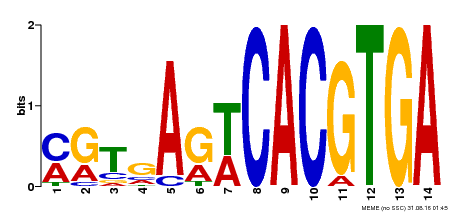 |
Plant Transcription
Factor Database
|
Transcription Factor Information
|
Basic
Information? help
Back to Top |
| TF ID |
Manes.16G015900.1.p |
| Organism |
|
| Taxonomic ID |
|
| Taxonomic Lineage |
cellular organisms; Eukaryota; Viridiplantae; Streptophyta; Streptophytina; Embryophyta; Tracheophyta; Euphyllophyta; Spermatophyta; Magnoliophyta; Mesangiospermae; eudicotyledons; Gunneridae; Pentapetalae; rosids; fabids; Malpighiales; Euphorbiaceae; Crotonoideae; Manihoteae; Manihot
|
| Family |
bHLH |
| Protein Properties |
Length: 211aa MW: 24076.5 Da PI: 4.7396 |
| Description |
bHLH family protein |
| Gene Model |
| Gene Model ID |
Type |
Source |
Coding Sequence |
| Manes.16G015900.1.p | genome | JGI | View CDS |
|
| Signature Domain? help Back to Top |
 |
| No. |
Domain |
Score |
E-value |
Start |
End |
HMM Start |
HMM End |
| 1 | HLH | 38.8 | 1.7e-12 | 43 | 87 | 6 | 55 |
HHHHHHHHHHHHHHHHHHHCTSCCC...TTS-STCHHHHHHHHHHHHHHH CS
HLH 6 nerErrRRdriNsafeeLrellPkaskapskKlsKaeiLekAveYIksLq 55
+ErrRR+++ +++ Lr+l+P+ + ++Ka+i e A+ YI++Lq
Manes.16G015900.1.p 43 LLAERRRRKKLSDRLLALRSLVPTI-----TNMNKATIIEDAITYIQELQ 87
578*********************6.....58*****************9 PP
|
| Gene Ontology ? help Back to Top |
| GO Term |
GO Category |
GO Description |
| GO:0006355 | Biological Process | regulation of transcription, DNA-templated |
| GO:0048658 | Biological Process | anther wall tapetum development |
| GO:0005634 | Cellular Component | nucleus |
| GO:0003700 | Molecular Function | transcription factor activity, sequence-specific DNA binding |
| GO:0043565 | Molecular Function | sequence-specific DNA binding |
| GO:0046983 | Molecular Function | protein dimerization activity |
| Sequence ? help Back to Top |
| Protein Sequence Length: 211 aa
Download sequence Send
to blast |
MEFIGSSMNE FCITDEDNNR RYGRLGRRSV DYDDTREYKS KNLLAERRRR KKLSDRLLAL 60
RSLVPTITNM NKATIIEDAI TYIQELQQNV KLLSDQLLEM EASSEEAVQT RGDEIKAEEE 120
EMKQCGIMED VQVTNIDGNK LWIKIILEKK RGRFTRLIEA MTYLGLELTD TNVTTSKGAM 180
LVSSCVEGSY GDTLTVEQTK VFLLEIITSI *
|
| Functional Description ? help
Back to Top |
| Source |
Description |
| UniProt | Transcription factor. Involved in the control of tapetum development. Required for male fertility and pollen differentiation, especially during callose deposition. {ECO:0000269|PubMed:16831835}. |
| Publications
? help Back to Top |
- Skinner MK,Rawls A,Wilson-Rawls J,Roalson EH
Basic helix-loop-helix transcription factor gene family phylogenetics and nomenclature.
Differentiation, 2010. 80(1): p. 1-8
[PMID:20219281] - Jiang J,Zhang Z,Cao J
Pollen wall development: the associated enzymes and metabolic pathways.
Plant Biol (Stuttg), 2013. 15(2): p. 249-63
[PMID:23252839] - Qian H, et al.
Trace concentrations of imazethapyr (IM) affect floral organs development and reproduction in Arabidopsis thaliana: IM-induced inhibition of key genes regulating anther and pollen biosynthesis.
Ecotoxicology, 2015. 24(1): p. 163-71
[PMID:25348600] - Shumin Z, et al.
One novel cis-element is essential for correct DYSFUNCTIONAL TAPETUM 1 (DYT1) expression in Arabidopsis thaliana.
Plant Cell Rep., 2015. 34(10): p. 1773-80
[PMID:26134855] - Cui J, et al.
Feedback Regulation of DYT1 by Interactions with Downstream bHLH Factors Promotes DYT1 Nuclear Localization and Anther Development.
Plant Cell, 2016. 28(5): p. 1078-93
[PMID:27113773] - Arkadir D, et al.
DYT1 dystonia increases risk taking in humans.
Elife, 2017.
[PMID:27249418] - Premi E, et al.
Functional Connectivity Networks in Asymptomatic and Symptomatic DYT1 Carriers.
Mov. Disord., 2016. 31(11): p. 1739-1743
[PMID:27453152] - Beauvais G, et al.
Disruption of Protein Processing in the Endoplasmic Reticulum of DYT1 Knock-in Mice Implicates Novel Pathways in Dystonia Pathogenesis.
J. Neurosci., 2016. 36(40): p. 10245-10256
[PMID:27707963] - Richter F,Gerstenberger J,Bauer A,Liang CC,Richter A
Sensorimotor tests unmask a phenotype in the DYT1 knock-in mouse model of dystonia.
Behav. Brain Res., 2017. 317: p. 536-541
[PMID:27769743] - Zhou S, et al.
Function Identification of the Nucleotides in Key cis-Element of DYSFUNCTIONAL TAPETUM1 (DYT1) Promoter.
Front Plant Sci, 2017. 8: p. 153
[PMID:28261229] - Li DD,Xue JS,Zhu J,Yang ZN
Gene Regulatory Network for Tapetum Development in Arabidopsis thaliana.
Front Plant Sci, 2017. 8: p. 1559
[PMID:28955355] - Ponterio G, et al.
Enhanced mu opioid receptor-dependent opioidergic modulation of striatal cholinergic transmission in DYT1 dystonia.
Mov. Disord., 2018. 33(2): p. 310-320
[PMID:29150865] - György B, et al.
Mutant torsinA in the heterozygous DYT1 state compromises HSV propagation in infected neurons and fibroblasts.
Sci Rep, 2018. 8(1): p. 2324
[PMID:29396398]
|





